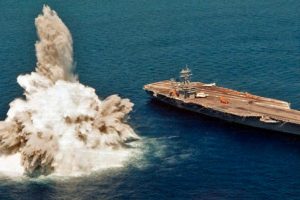The Navy's new, powerful aircraft carrier is heading to 'shock trials'

- The US Navy’s brand-new aircraft carrier USS Gerald R. Ford will be return to port this summer.
- But before the supercarrier ties up in Newport News, it will go through full-ship shock trials,
- Those tests involve setting off explosives next to the ship to see if vibrations cause problems.
- See more stories on Insider’s business page.
The US Navy’s brand new aircraft carrier USS Gerald R. Ford (CVN-78) will be returning to Newport News this summer.
Much like how an automobile needs to go in for routine maintenance, so too will the Navy’s largest and most expensive warship.
Coming soon: USS Gerald R. Ford shock trials
The supercarrier will tie up at Newport News Shipbuilding’s pier 2 after it conducts its full ship shock trials, which is a standard test that involves setting off high explosives next to the ship to determine if vibration would cause problems.
While anything that was shaken loose or damaged will be addressed, the return to port is actually part of Ford’s first “planned incremental availability” (PIA).
This maintenance period is meant to install the latest updates to equipment and to take care of maintenance work that’s harder to do while the ship is deployed at sea.
The updates and upgrades are expected to be completed quickly, in part because the ship has only been undergoing at-sea tests and trials that are meant to certify the carrier’s systems as well as sailor skills.
However, just as “brand new” computers or smartphones often need to undergo software updates on a regular basis, so too will Ford’s various systems.
According to Hampton Roads-based Daily Press, about 60% of the work slated for the PIA involves updating and modernizing equipment. That includes plugging in updated circuit boards and installing new communications networks and software.
PIA updates will occur every few years to keep the carrier up to date with the fast-changing electronic devices, software, weapons system controls and communication networks.
Routine maintenance
During Ford’s time at Newport News, the ship will undergo maintenance. This could be extensive as the carrier is the first of her class, and part of the focus will be making notes on the wear and tear she’s already experienced. Teams will evaluate the components to see how the ship held up compared to what the designers expected.
These efforts will help refine the long-term maintenance plan for a carrier that is expected to remain in service for half a century. Twenty percent of the total work that the carrier will undergo will involve that maintenance.
About 8% of the scheduled work time will also be to address any fixes needed following the shock trials, which are the first such trial of a carrier to be conducted since 1987.
The remainder of the time will be spent addressing and fixing any of the other systems of the ship. This will certainly include dealing with four inoperable weapons elevators.
The lower-stage elevators, which are used to move ordnance, have been a problem since construction began on CVN-78 in 2009. Four of the eleven elevators will be dealt with during the PIA, and the non-working elevators will not be certified at least until later this year.
It isn’t unusual for a warship to enter trials without essential working components including the elevators, but the kinks will need to be worked out and resolved before Gerald R. Ford makes her first deployment.
A concern is that since the elevators are located throughout the ship, each could potentially react differently to the shock trials. That could result in further delays for additional repairs and adjustments, which impact the future carriers of the class.
When Ford returns to Newport News it will be moored adjacent to one of those future carriers, the still-under-construction USS John F. Kennedy, the second in the class, UPI reported.
Ford most recently completed the Combat Systems Ship’s Qualification Trials (CSSQT), a combat preparation phase involving simulated and actual live threats to assess the extent to which a large Ford-class carrier could defend itself in a great power ocean war scenario.
Peter Suciu is a Michigan-based writer who has contributed to more than four dozen magazines, newspapers and websites. He regularly writes about military small arms, and is the author of several books on military headgear including “A Gallery of Military Headdress,” which is available on Amazon.com.
Source: Read Full Article
